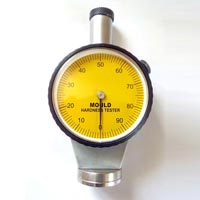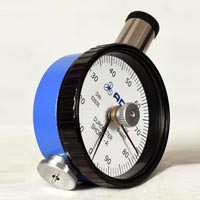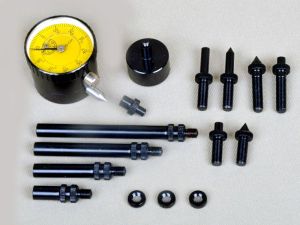
mould hardness tester
Manufactured in accordance with AFS specifications, our Mould Hardness Tester is used to determine surface hardness of green sand mould. We are reckoned among the prominent Manufacturers and Suppliers of Mould Hardness Tester. The Hardness test can be performed within seconds; user simply presses the tester against the mold surface and notes reading on the dial. Details A 1/2 in. (12.7 mm) radius ball contact point is loaded with a spring pressure of 980 g. The softer the mold surface, the greater the penetration into the mold. A mold offering no resistance to the contact point would have a zero reading and one having hardness capable of preventing penetration would read 100. A maximum reading stop holds the reading when testing in blind portions of the mold
Frequency : 45Hz
Warranty : 1year
Temperature Capacity : High Temperature, Low Temperature
Height : App. 4 in. (108 mm.)
...more
Durometers
Durometer Technical Information The principle used to measure hardness is based on measuring the resistance force of the penetration of a pin into the test material under a known spring load. The amount of penetration (max. 2.54 mm / 0.1 in.) is converted to hardness reading on a scale with 100 units. Whenever possible, a Durometer measurement should be taken at least 12 mm (approx. 0.500") in from the edge of a sample, as the hardness characteristic of any sample tends to change at the edges. Whenever possible, the thickness of a sample should exceed 6 mm (approx. 0.250"). If the sample is thinner then this, then the sample can be backed with a sample of the same material to increase the thickness. Test Coupons or test blocks (rubber or plastic) should not be used for calibration verification. As all samples are subject to characteristic changes over time along with temperature and lighting conditions, the rated Shore value when supplied as new can and will vary with age. Proper calibration verification requires independent confirmation of the internal spring forces along with the verification of the pin displacement vs. the indicated value on the scale. As per the ASTM D2240 Standard, readings below 10 and above 90 are not to be considered reliable and should be discarded. Therefore, it is important to select the approapriate Scale that will provide results between 10-90 units. Frequently Asked Questions "My durometer rests below zero, is it out of calibration?" This is a common question asked by durometer users. The answer to the question, in most cases, is no. This is because the gauges are made in accordance with ASTM D2240 Standard, which states that some durometers have a preload of 56g at a zero reading. Therefore, a durometer giving a less-than-zero reading at rest is not out of calibration.
...more
Crankshaft Deflection Gauge
Compact and robust construction, reliable performance and long functional life make our Crankshaft Deflection Gauge the preferred choice among customers. The company stands tall among the prominent Manufacturers and Suppliers of Crankshaft Deflection Gauge in Vadkun, Dahanu, and Maharashtra, India. These Crankshaft Deflection Gauges are used to check the alignment and deflection on all type of crankshaft. Our Crankshaft Deflection Gauge has easy adjustment of gauge position. Customers can purchase the Deflection Gauge at market leading rates.
Size : 2inch, 4inch, 8inch
Material : Brass, Mild Steel, Stainless Steel
Diameter : 20-40mm, 80-100mm
Shape : Round
Application : Liquid Pressure, Measuring Gas
Display Type : Analog
Pressure : 0-5000psi
Feature : Perfect Strength, Robust Construction
...moreOpening Hours